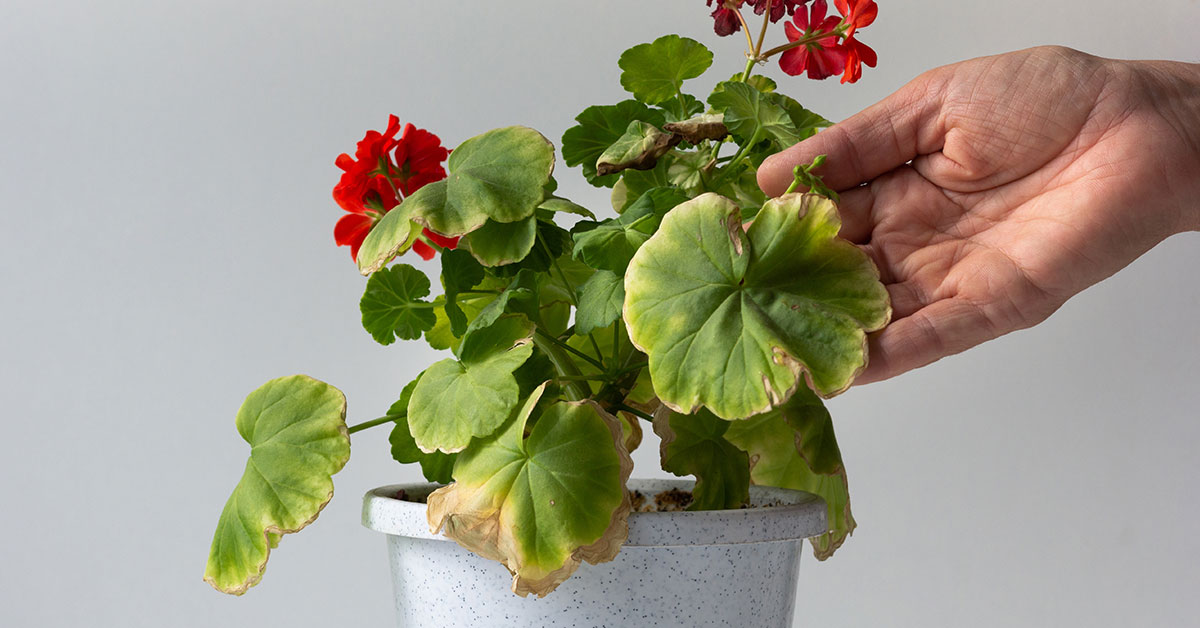Geraniums are popular, bright, and cheerful plants that are ideal for adding a splash of color to any garden or window sill. They’re valued for their ease of care, resilient nature, and varied colors. Despite this, even these hardy beauties can occasionally succumb to a host of problems, one of the most common being yellowing leaves.
When your geranium leaves start to turn yellow, it’s an indication that the plant is under stress. However, identifying the cause can sometimes be a bit tricky. Here’s a look into some of the most common reasons why geranium leaves may turn yellow, and what you can do to get your plant back to its full health.
Why are your geranium leaves turning yellow?
Yellowing leaves on geranium plants can be caused by several factors, including improper watering, nutrient deficiencies, pests, diseases, or environmental stress. Here are some common reasons why geranium leaves may turn yellow and how to address each issue:
- Overwatering or Underwatering: Both overwatering and underwatering can lead to yellowing leaves. Ensure that you are watering your geraniums appropriately, allowing the soil to slightly dry out between waterings. Adjust your watering schedule to provide consistent moisture without waterlogging the soil.
- Nutrient Deficiencies: Yellowing leaves may indicate a lack of essential nutrients. Geraniums require a balanced fertilizer with adequate amounts of nitrogen, phosphorus, and potassium. Consider using a slow-release fertilizer or a water-soluble fertilizer to provide necessary nutrients. Yellowing due to nutrient deficiencies can also be addressed by incorporating organic matter or compost into the soil.
- Pests: Pests such as aphids, spider mites, or whiteflies can infest geraniums and cause yellowing leaves. Inspect the leaves, stems, and undersides for signs of pests or sticky residue. Use appropriate insecticidal soaps, oils, or organic pest control methods to manage and eliminate the pests.
- Diseases: Geraniums can be susceptible to diseases like bacterial leaf spot, fungal infections, or viral diseases, which can cause yellowing and browning of leaves. Remove and destroy infected leaves or plants, practice good sanitation, and consider using appropriate fungicides or treatments to control and prevent disease spread.
- Environmental Stress: Environmental factors such as extreme temperatures, high humidity, or insufficient light can stress geraniums and lead to yellowing leaves. Ensure that your plants are situated in a suitable location with adequate sunlight and proper air circulation. Protect them from temperature extremes and provide shade during hot periods if necessary.
- Aging Leaves: It’s normal for older leaves on geranium plants to yellow and eventually drop off as part of their natural growth cycle. As long as new growth appears healthy, the yellowing of older leaves is typically not a cause for concern.
To address yellowing leaves on geraniums, it’s essential to identify the specific cause and take appropriate action. Regular monitoring, proper watering, balanced nutrition, pest management, and providing optimal growing conditions will help maintain the health and vibrancy of your geranium plants. If the problem persists or worsens, consult a local gardening expert or an agricultural extension service for further assistance and diagnosis.
Caring for your geranium plant
After addressing the issue of yellowing leaves on a geranium plant, it’s important to provide ongoing care to promote its recovery and overall health. Here are some guidelines for caring for a geranium plant after yellowing leaves:
- Watering: Maintain proper watering practices. Allow the soil to slightly dry out between waterings, then water the plant thoroughly. Avoid overwatering, as it can lead to root rot and other issues. Adjust your watering schedule based on the specific needs of your geranium and the environmental conditions.
- Fertilization: Feed your geranium plant with a balanced fertilizer formulated for flowering plants. Follow the recommended application rates and frequency specified on the fertilizer packaging. Regular fertilization helps provide the necessary nutrients for healthy growth and blooming.
- Pruning: Remove any remaining yellow or diseased leaves, as they may continue to sap energy from the plant. Use clean and sharp pruners to make precise cuts just above healthy buds or leaves. Pruning encourages new growth and helps maintain a compact and attractive shape.
- Pest and Disease Management: Monitor your geranium plant regularly for signs of pests or diseases. Take appropriate action, such as applying insecticidal soaps or organic pest control methods, to manage any pest infestations. If diseases persist, consider using recommended fungicides or treatments. Good sanitation practices, such as removing and disposing of infected plant material, are crucial for preventing the spread of diseases.
- Light and Temperature: Place your geranium plant in a location that provides adequate sunlight. Geraniums generally require 6 to 8 hours of direct or bright indirect sunlight daily. Avoid exposing them to extreme temperatures or drafts, as these can stress the plant. Maintain a suitable temperature range for optimum growth.
- Air Circulation: Ensure good airflow around your geranium plant. Proper air circulation helps prevent the development of fungal diseases and enhances the overall health of the plant. Avoid overcrowding and space out your geraniums appropriately.
- Regular Maintenance: Conduct routine maintenance tasks such as removing spent flowers (deadheading) to promote continuous blooming and prevent seed formation. Regularly inspect the plant for signs of new issues, pests, or diseases and take appropriate measures to address them promptly.
By providing the right care, your geranium plant should recover and produce healthy new growth. Remember to adjust the care routine based on the specific needs of your geranium variety and the local growing conditions. With consistent attention and appropriate care, your geraniums will thrive and reward you with their vibrant blooms.













